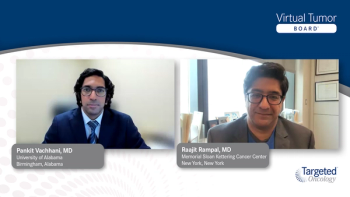
Case 2: Metastatic RCC, Favorable Risk
Eric Jonasch, MD, discusses a 62-year-old man with favorable-risk metastatic RCC and goals and treatment options for such a patient.
Episodes in this series

Robert Motzer, MD: This is Case 2. This is a patient who has metastatic RCC [renal cell carcinoma] with favorable-risk features, presented by Dr Eric Jonasch.
Eric Jonasch, MD: Thanks, Bob. This is a 62-year-old man with a history of metastatic renal cell carcinoma, post–left nephrectomy and adrenalectomy, demonstrating clear cell renal cell carcinoma with metastases in the adrenal gland. Two years later, this patient recurred in the lung with nodules there, and these were biopsied and were consistent with clear cell renal cell carcinoma. This patient was observed based on the fact that they had low-volume indolent disease, and also because of patient preference. Two years later, you see continued indolent growth on scans. Eighteen months later, you see continued indolent growth on scans. At this point, the increased total tumor burden at multiple lung nodules increases to a slightly larger extent.
Robert Motzer, MD: Thanks for that presentation of the case, Eric. What is it that makes this patient favorable risk? By what criteria is that assignment made?
Eric Jonasch, MD: Looking at either the MSKCC [Memorial Sloan Kettering Cancer Center] or the IMDC [International Metastatic RCC Database Consortium] risk criteria, we look at whether the patient is longer than 1 year from initial diagnosis to systemic therapy, which they clearly match. Then there are other things, like performance status, hypercalcemia, and depending on which 1 you’re looking at, LDH [lactate dehydrogenase], white blood cell count, leukocytosis, and thrombocytosis. It looks like this patient doesn’t have any of these negative factors. Also, the striking thing about this patient obviously is the unmistakable indolence of this disease.
Robert Motzer, MD: The initial strategy for this patient was surveillance at the time the metastases were identified. Is that a viable strategy for managing these patients with metastatic disease?
Eric Jonasch, MD: In 2021 it still is, and in an individual where there’s evidence of oligometastatic disease that’s low volume and slow growing in nonthreatening areas in the body, these individuals can benefit from surveillance. There are some studies—they’re small studies, and they’re not randomized—that have been published demonstrating that if you do so, you’re not jeopardizing these individuals and you’re not decreasing the probability of benefit from systemic therapy when you do start it.
Robert Motzer, MD: When you’re following these patients, how do you make a decision when to “pull the trigger” and start therapy for a patient like this?
Eric Jonasch, MD: This isn’t science; this is art of medicine. But it’s an acceleration of growth rate of existing lesions and the development of new organ sites of involvement. For example, if this individual suddenly started developing a bone metastasis, starting to develop a liver metastasis, or developed new multiple mediastinal lymph nodes, that clearly would trigger me to initiate systemic therapy. We saw on the previous slide that this individual also started having a general increase in disease burden. For this 1, we want to look at the scans in detail to make a determination of whether it passes this threshold.
Robert Motzer, MD: The mainstay of therapy for RCC has been TKI [tyrosine kinase inhibitor] monotherapy, and more recently I/O [immuno-oncology] combinations have been studied and shown to be beneficial to the entire patient population. But 1 of the questions that’s come up with these favorable-risk patients is, is it really necessary or is there a role for I/O therapy in treatment of favorable risk? What’s your opinion on that, Bradley?
Bradley McGregor, MD: Favorable-risk renal cell carcinoma is probably the area of greatest debate when we think about renal cell carcinoma. Certainly, we’ve seen major advantages in the frontline therapy for advanced renal cell carcinoma with these incredible outcomes of combination-based therapies extending across risk groups. But then it’s not prespecified. Thus, when you start looking at those favorable-risk populations, the first follow-up it looks great, and then with extended follow-up. The benefit of that TKI–I/O combination is a little less clear within the limits of separate analysis. When you think about nivolumab and ipilimumab, the primary end point was looking at outcomes in intermediate-and poor-risk disease. In that initial analysis we saw a marked difference where the PFS [progression-free survival] and objective response rate were markedly better with sunitinib vs nivolumab-ipilimumab in those favorable-risk patients.
We’ve seen extended follow-up at ESMO [European Society for Medical Oncology Congress], and if you look at that extended overall survival in the favorable-risk group, it was 74 months with nivolumab-ipilimumab vs 68 months with sunitinib. With those conditional survivals, we see that if you do respond to nivolumab-ipilimumab where the CR [complete4 response] rates are still over 10%, it seems to be long lasting. Thus, it does come down to a really long discussion. TKI–I/O is certainly a reasonable option. After a long discussion, I/O–I/O can certainly be considered. Then do you need to keep I/O at all? Can you think about TKI monotherapy? We had the fortunate option to have a trial in the frontline setting where we’re looking at a single arm of cabozantinib with belzutifan, the HIF2 [Hypoxia-Inducible Factor-2 Alpha] inhibitor, in treatment-naïve patients. That tends to be a great option for these favorable-risk disease patients, to give them a little more therapy up front to hope for something.
But it comes down to a long discussion with the patient about what makes sense. I always wonder about prolonged TKI–I/O in a favorable-risk patient: is that increase in toxicity from the 2 agents together going to be the best long-term option for the patient, or could you get by with a sequential approach?
Robert Motzer, MD: Tom, what do you think in terms of VEGF-TKI [vascular endothelial growth factor – tyrosine kinase inhibitor] monotherapy for this patient? Would that be your choice, or would you tend to offer him an I/O in combination?
Tom Hutson, DO, PharmD: The case highlights the natural history of RCC, although the best predictor of how someone’s cancer is going to behave is how it has been behaving. We know that this scenario exists where patients can have prolonged periods of very indolent disease, and then all of a sudden, for reasons not clear, have more explosive disease. The way the case was presented, at least my interpretation of it, was it was very indolent and now there are multiple pulmonary nodules, so that almost suggests that there’s much more rapid development of disease. Although single-agent TKIs could be considered a long-term strategy, we’re not putting patients in an NED [no evidence of disease] state with that. I’d still lean toward a therapy that’s likely to put the patient in an NED state with the thought of potentially discontinuing therapy altogether. It’s a contentious area. You can make strong arguments on both sides, but we do have therapies with higher chances of NED status. It would be very difficult not to want to go that route, but it’s obviously the patient’s choice.
Transcript edited for clarity.







































